Peru is home to an incredible variety of birds, with over 1800 species recorded nationwide. These species range from the majestic Andean Condor to the vibrant and colorful Toucan to the elusive and well-camouflaged Cotinga.
Peru is a birdwatcher’s paradise, with many national parks and reserves offering the perfect opportunity to spot and appreciate the wide range of birds that call Peru home.
49 Most Unique Birds In Peru
Peru is rich in natural beauty and biodiversity, especially regarding birds. With more than 1800 species of birds, Peru has the second highest number of bird species in the world, after Colombia. Many of these birds are endemic, meaning they are found nowhere else on Earth.
We will introduce you to 49 of the most unique birds in Peru, from the majestic Andean condor to the tiny marvelous spatuletail. Whether you are a birdwatcher, a nature lover, or just curious, you will surely be amazed by the diversity and beauty of these feathered creatures.
1. Andean Condor
The Andean condor is a giant South American Cathartid vulture and its only genus member.
Found in the Andes mountains and along Pacific coasts, it is thought to be the most giant flying bird on Earth by weight and wingspan, with a maximum wingspan reaching up to 10 feet 10 inches (3.3 m) and weighing 33 lbs (15 kg).
It has mainly black plumage, which helps keep it warm at high altitudes, while white patches adorn its head, neck, and chest, and underwing coverts.
Its robust bill allows it to consume carrion efficiently while also being able to crack bones for nutrition when necessary.
This majestic creature’s unique flight capabilities allow it to soar through air thermals effortlessly, making it an impressive sight against clear blue skies.
Scientific classification:
| Kingdom | Animalia |
| Phylum | Chordata |
| Class | Aves |
| Order | Accipitriformes |
| Family | Cathartidae |
| Genus | Vultur Linnaeus, 1758 |
| Species | V. gryphus |
2. Marvelous Spatuletail
The Marvelous Spatuletail is an endangered species of hummingbird found only in northern Peru. It’s the sole member of its genus and belongs to the ‘brilliants’ tribe Heliantheini, which falls under the subfamily Lesbiinae.
This remarkable bird has two long tail feathers with bright blue discs at their tips for courtship displays and protection from predators. Its vibrant colors also help it attract mates during breeding season.
As a result of deforestation and over-collection by collectors, this unique species faces extinction unless conservation efforts can be put in place to protect them and their habitats.
Scientific classification:
| Kingdom | Animalia |
| Phylum | Chordata |
| Class | Aves |
| Order | Apodiformes |
| Family | Trochilidae |
| Tribe | Heliantheini |
| Genus | Loddigesia Bonaparte, 1850 |
| Species | L. mirabilis |
3. Andean Cock-Of-The-Rock
The Andean cock-of-the-rock is a large passerine bird belonging to the Cotinga family. It has four subspecies and can be found in the cloud forests of South America, notably Peru, where it has been declared its national bird.
This species exhibits marked sexual dimorphism; males have an impressive orange crest covering most of their heads and a bright coral chest patch, while females are mainly grey with dark wings and tail feathers.
Both sexes also feature black heads, yellow eyes, long bills, and short legs.
Their diet consists mainly of fruits, but they are known to eat small insects for protein.
They are monogamous birds that mate for life, forming strong pair bonds that last several years until one partner dies or moves away from its territory.
Scientific classification:
| Kingdom | Animalia |
| Phylum | Chordata |
| Class | Aves |
| Order | Passeriformes |
| Family | Cotingidae |
| Genus | Rupicola |
| Species | R. peruvianus |
4. Humboldt Penguin
The Humboldt Penguin is a medium-sized bird that resides in South America, mainly along the coastal regions of Peru. It belongs to the same family as African Penguins, Magellanic Penguins, and Galapagos Penguins.
The species was named after Alexander von Humboldt, an explorer who first discovered it during his travels. With its black and white plumage, they are easily recognizable by their distinctive pink tufts on their face and feet.
Despite being listed as vulnerable due to habitat loss and hunting for food or feathers, these penguins have adapted well to the human presence around them, making colonies close to fishing villages near rocky coasts with abundant shelter from predators like sea lions and seals.
They feed primarily on anchovies but eat other fish, such as sardines, if available nearby.
Conservation efforts must be taken soon to protect this unique creature from extinction.
Scientific classification:
| Kingdom | Animalia |
| Phylum | Chordata |
| Class | Aves |
| Order | Sphenisciformes |
| Family | Spheniscidae |
| Genus | Spheniscus |
| Species | S. Humboldt |
Also Featured In: Birds You’ll Find in Zoo,
5. Inca Tern
The Inca tern, found exclusively in the Humboldt Current on Peru and Chile’s coasts, is a striking bird of uncommon beauty.
It has unique plumage that sets it apart from other birds in its family, Laridae.
Recently, a single individual was seen making an unexpected appearance at Hawaii’s Big Island and Oahu shores – an unheard-of occurrence.
They are also known to make rare visits to the Ecuadorian southwest coast.
A graceful flyer with elegant wingspans, the Inca tern is truly remarkable for its unusual characteristics – one worth seeing if you ever get the chance.
Scientific classification:
| Kingdom | Animalia |
| Phylum | Chordata |
| Class | Aves |
| Order | Charadriiformes |
| Family | Laridae |
| Genus | Larosterna Blyth, 1852 |
| Species | L. inca |
Also Featured In: Most Common Birds in South America Birds,
6. Hoatzin
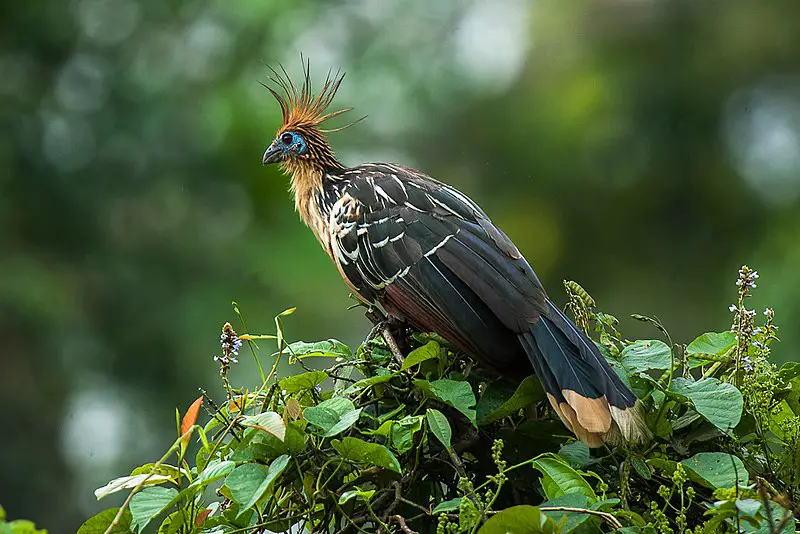
The Hoatzin bird is a tropical species found in South America’s Amazon and Orinoco river basins. It inhabits swamps, riparian forests, and mangroves.
This unique bird has chicks with claws on two of their wing digits, making it the only member in its order – Opisthocomiformes.
Its most distinctive feature is an odor from its digestive system, which smells like cow manure.
The adults are brownish-grey with blue facial skin, red eyes, pointed crest feathers, and black primaries.
They feed mainly on leaves but also eat flowers, fruits, or buds when available during different seasons.
They can be heard making loud calls resembling caws at night and repeated whistles throughout the day to keep contact between family members within flocks.
Scientific classification:
| Kingdom | Animalia |
| Phylum | Chordata |
| Class | Aves |
| Order | Opisthocomiformes |
| Family | Opisthocomidae |
| Genus | Opisthocomus Illiger, 1811 |
| Species | O. hoazin |
7. Wattled Jacana
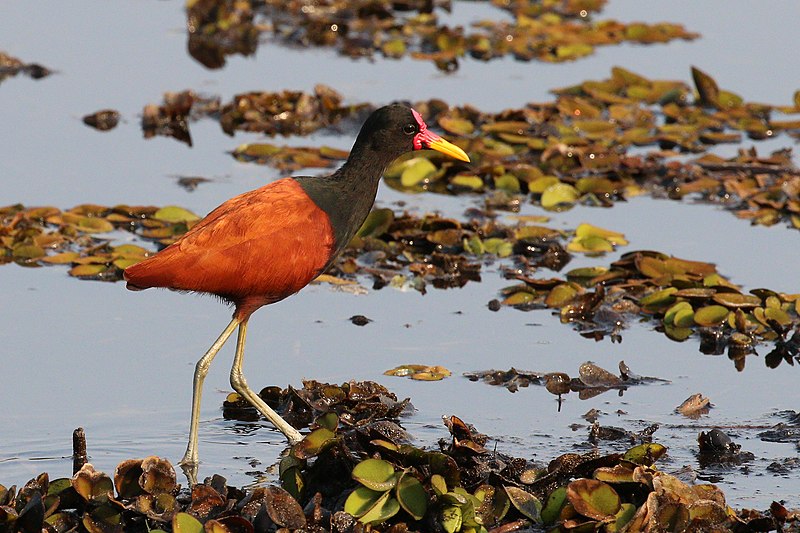
The Wattled Jacana is a stunning bird from Central and South America. It has long legs, a black head with yellow wattles at each side, and striking chestnut brown wings.
This wader builds its nest on the surface of ponds or lakes using floating vegetation such as lily pads to anchor it in place – usually with four eggs that are darkly marked.
The male is primarily responsible for incubating these eggs between his wings, while the female takes care of her chicks once they hatch.
If available, these birds feed mainly on aquatic insects, small fish, and amphibians.
Overall, this species is an exciting addition to any wetland habitat.
Scientific classification:
| Kingdom | Animalia |
| Phylum | Chordata |
| Class | Aves |
| Order | Charadriiformes |
| Family | Jacanidae |
| Genus | Jacana |
| Species | J. jacana |
8. White-Winged Guan
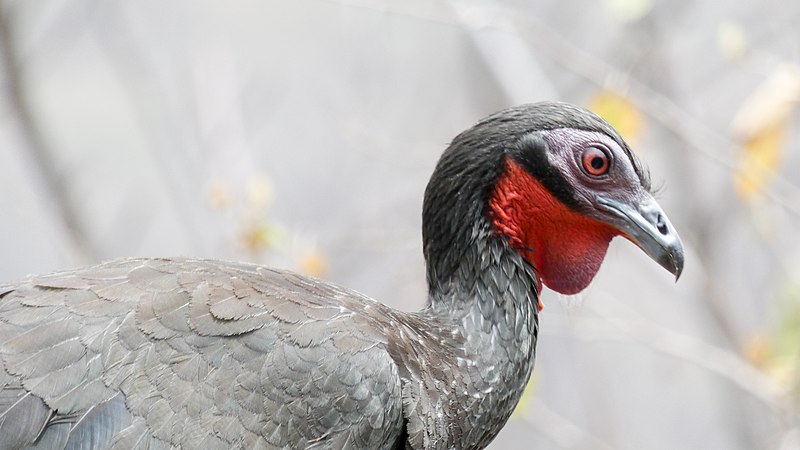
The White-winged Guan is a bird species belonging to the family Cracidae. It is found exclusively in northwestern Peru and was initially known from three specimens collected between 1876 and 1877.
After that, it wasn’t seen until 1977, though there were some hints that it still existed as far back as 1969.
Surveys starting around 1980 revealed its presence again with individuals found mainly in humid montane forest regions at higher altitudes.
This gun has white wings and a red throat pouch on males, while females have more brown feathers overall with light barring on their chests.
They are also considered vulnerable due to habitat loss caused by logging activities occurring within the area where they live, mixed with hunting for food or sport, further reducing numbers in wild populations.
Scientific classification:
| Kingdom | Animalia |
| Phylum | Chordata |
| Class | Aves |
| Order | Galliformes |
| Family | Cracidae |
| Genus | Penelope |
| Species | P. albipennis |
9. Waved Albatross
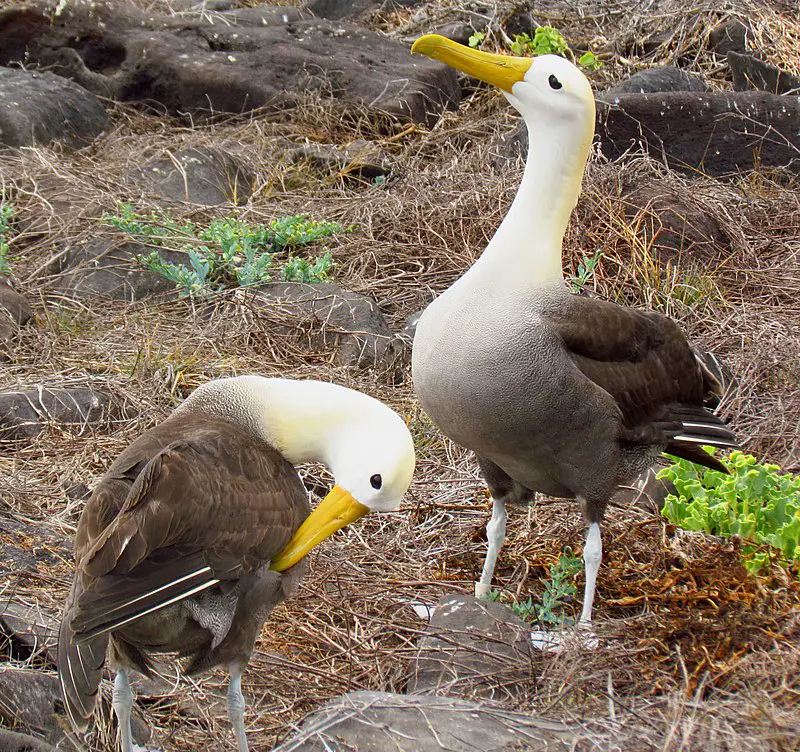
The Waved Albatross is a stunning bird with distinctive black and white plumage. It is the only species of its family, Diomedeidae, inhabiting tropical regions.
During the breeding season, they can be found chiefly near Ecuadorian and Peruvian coasts, while during the non-breeding season, they travel up to 1,000 km east towards Peru’s coastline foraging food.
These birds are graceful gliders soaring through the skies using their long wingspans to navigate winds effortlessly when searching for prey like fish or squid at the sea surface.
They also have an impressive courtship ritual involving head nodding, which was once thought extinct but thankfully has been sighted again on Galapagos islands recently.
Scientific classification:
| Kingdom | Animalia |
| Phylum | Chordata |
| Class | Aves |
| Order | Procellariiformes |
| Family | Diomedeidae |
| Genus | Phoebastria |
| Species | P. irrorata |
Also Featured In: Galapagos Birds You Should Know, Common Latin America Birds
10. Chilean Flamingo
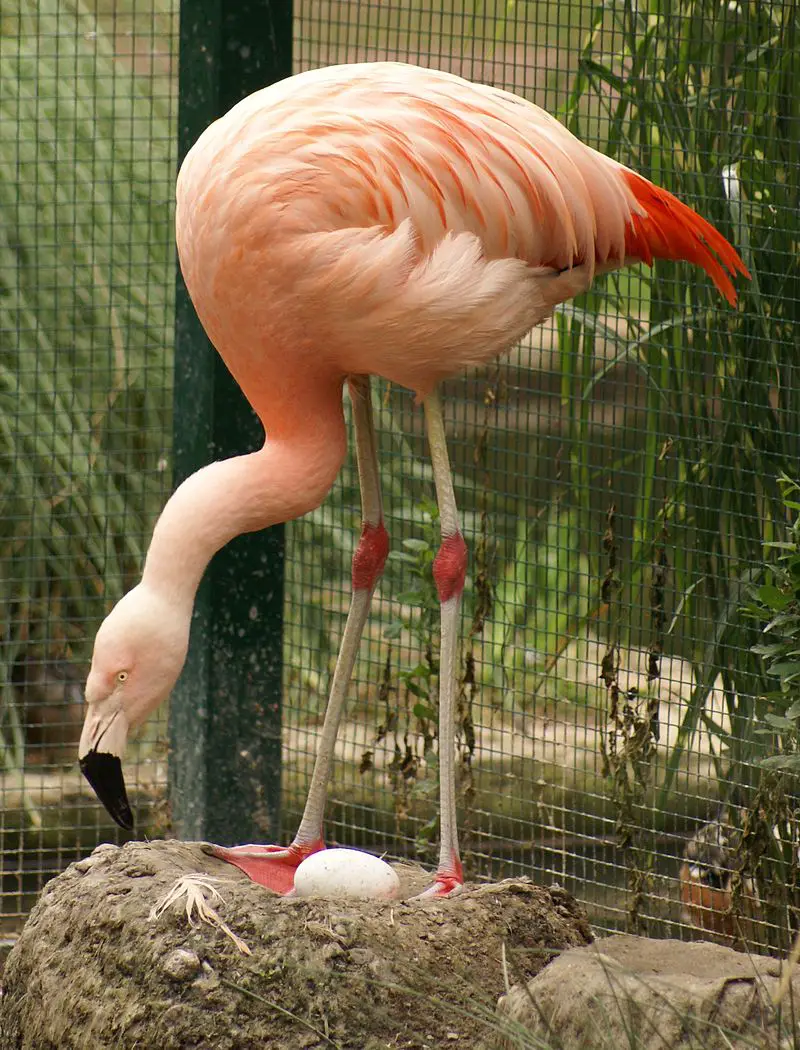
The Chilean Flamingo is a large bird native to South America, ranging from Ecuador and Peru to Chile and Argentina. It is an impressive species of Flamingo, which stands 43-51 inches tall.
Its distinctive long neck, bright pink feathers, and black-tipped wings are a sight.
Unfortunately, the population of this majestic creature has been decreasing over time due to human activities such as hunting for their meat or eggs.
The IUCN lists them as near threatened, meaning we must act now if we want future generations to experience these beautiful birds in person.
We must be more responsible with our actions so that these iconic animals can live peacefully without fear of harm from humans
Scientific classification:
| Kingdom | Animalia |
| Phylum | Chordata |
| Class | Aves |
| Order | Phoenicopteriformes |
| Family | Phoenicopteridae |
| Genus | Phoenicopterus |
| Species | P. chilensis |
Also Featured In Patagonia Birds You Should Know, Birds Live In San José Island
11. Black Skimmer
The Black Skimmer is a seabird that belongs to the skimmer genus Rynchops and Laridae family.
It breeds in North and South America, while Northern populations migrate south for winter towards warmer climates such as the Caribbean or Pacific coasts.
The Southern American races have adapted to annual floods by migrating shorter during this time.
These birds are easily identified by their unique long red bill with an upper mandible longer than its lower mandible.
They feed mainly on small fish caught at night when they skim across shallow water using their beak like a knife cutting through waves of water.
Their dark grey back contrasts against white belly feathers, creating beautiful patterns in flight, aiding them in catching prey easier due to their camouflage effect above and below the water’s surface.
Scientific classification:
| Kingdom | Animalia |
| Phylum | Chordata |
| Class | Aves |
| Order | Charadriiformes |
| Family | Laridae |
| Genus | Rynchops |
| Species | R. niger |
Also Featured In: Birds You’ll Find in the Sea, Birds Live Near San Diego
12. Plovers

Plovers comprise around 64-68 ground-dwelling birds, commonly found in open country fields, meadows, and tundras.
They have short bills with webbed feet to help them forage through mud or shallow water.
Plover plumage is usually mottled brown, though some species may have brighter colors on the head and wings.
These birds feed mainly on insects but can also eat small crustaceans and worms.
Plovers breed during springtime when they dig holes in sandy or pebbled beaches to lay their eggs, which hatch after about three weeks incubation period.
They use distraction display behavior by pretending an injury to the predators away from their nests if needed to protect their young ones.
Scientific classification:
| Kingdom | Animalia |
| Phylum | Chordata |
| Class | Aves |
| Order | Charadriiformes |
| Family | Charadriidae Leach, 1820 |
13. Grey-Winged Trumpeter
The Grey-winged Trumpeter is a species of bird found in South America, spanning Brazil, Colombia, Ecuador, and several other countries.
It belongs to the small family Psophiidae and has an uncertain taxonomy; this is being studied by various organizations such as the International Ornithological Committee (IOC).
They are usually around 35 cm long with grey wings and brown eyes. This species typically lives in humid lowland forests or adjacent woodlands.
Its diet consists mainly of fruits, seeds, and some invertebrates, which it finds on the ground or near trees.
The mating season for these birds occurs from October to February, when they build nests made out of twigs lined with leaves close to their food sources for protection against potential predators.
Although not currently threatened due to its wide range distribution across multiple countries, localized threats may need monitoring to survive into future generations.
Scientific classification:
| Kingdom | Animalia |
| Phylum | Chordata |
| Class | Aves |
| Order | Gruiformes |
| Family | Psophiidae |
| Genus | Psophia |
| Species | P. crepitans |
Also Featured In Common Tropical Rainforest Birds,
14. Red-Legged Cormorant
The red-legged cormorant is a species of seabird found along the coastlines of South America. It has an unusual appearance, as its feathers are primarily grey and stand out, with long red legs and feet.
Unlike most seabirds, this species lives alone instead of forming colonies. Red-legged cormorants have not been seen engaging in the behavior known as “wing spreading,” like other birds do to dry their wings after swimming or flying through water.
Instead, they often sunbathe on rocks or logs during warm weather for hours at a time until their plumage dries off naturally from the heat of the sun’s rays.
Scientific classification:
| Kingdom | Animalia |
| Phylum | Chordata |
| Class | Aves |
| Order | Suliformes |
| Family | Phalacrocoracidae |
| Genus | Poikilocarbo Boetticher, 1935 |
| Species | P. gaimardi |
15. Torrent Duck
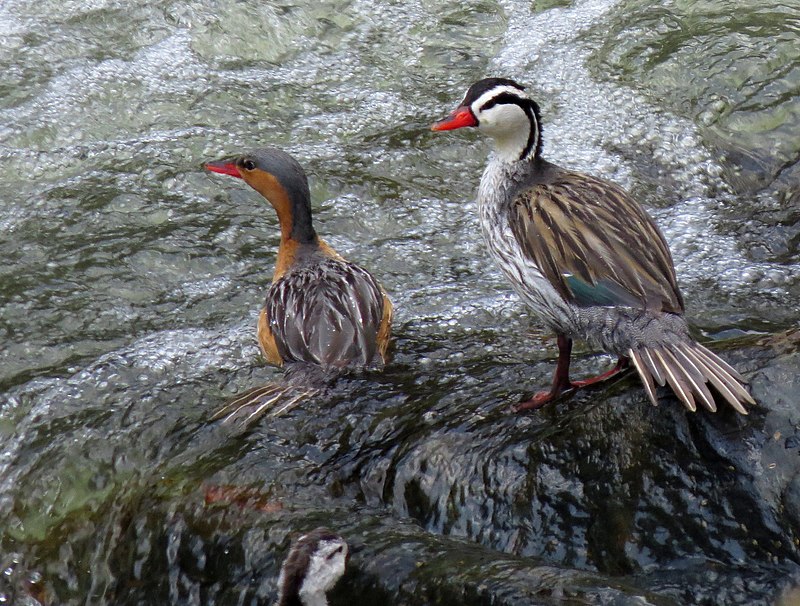
The Torrent Duck is a beautiful member of the duck, goose, and swan family Anatidae. It is found in mountainous regions throughout South America and measures 43-46 centimeters long.
This unique species has its genus – Merganetta armata – which belongs to the shelduck subfamily Tadorninae.
Its striking plumage includes dark brown feathers with shades of black to white on its wings, back, head, and yellow legs and feet.
They are mostly seen around fast-flowing streams or small rivers where they feed mainly on aquatic invertebrates such as shrimp, insects, worms, etc., but occasionally take some plant material.
These birds live in pairs most of the year, although they may form larger groups or flocks together during breeding season when looking for food resources.
Scientific classification:
| Kingdom | Animalia |
| Phylum | Chordata |
| Class | Aves |
| Order | Anseriformes |
| Family | Anatidae |
| Genus | Merganetta Gould, 1842 |
| Species | M. armada |
16. Peruvian Thick-Knee
The Peruvian thick-knee is an impressive bird belonging to the Burhinidae family. It has a unique appearance with its distinctive black and white plumage and striking yellow eyes.
This species can be found in Chile, Ecuador, and Peru, where it inhabits dry shrublands, seasonally wet or flooded lowland grasslands, and pasturelands. The Peruvian Thick-Knee is known as a ground dweller that feeds mainly on insects and small animals like lizards or frogs, if available.
It was formally described by French zoologist Charles Lucien Bonaparte in 1854 from specimens collected during his travels through South America, making this one of the oldest recognized birds native to these regions.
Scientific classification:
| Kingdom | Animalia |
| Phylum | Chordata |
| Class | Aves |
| Order | Charadriiformes |
| Family | Burhinidae |
| Genus | Burhinus |
| Species | B. superciliaris |
17. Darwin’s Rhea
Darwin’s rhea is a flightless bird, the smaller of two extant species of rheas. It stands at 35 to 39 inches tall and has an average length of 36-39 inches with a weight range between 33 – 63 lbs.
The head and bill are relatively small compared to other ratites.
This large bird can be found across the Altiplano and Patagonia regions in South America; it feeds on plants such as grasses, herbs, roots, bark, fruits, etc., while occasionally consuming insects and lizards.
Most notably, they use their powerful legs to run away from predators like foxes or pumas, who may attempt to hunt them down due to their slow speed when taking off or flying away isn’t possible.
Scientific classification:
| Kingdom | Animalia |
| Phylum | Chordata |
| Class | Aves |
| Infraclass | Palaeognathae |
| Order | Rheiformes |
| Family | Rheidae |
| Genus | Rhea |
| Species | R. pennata |
18. Black-Tailed Trainbearer
The Black-tailed Trainbearer is a species of hummingbird found in the mountain regions of Colombia, Ecuador, and Peru. These birds have an impressive 21- and 24 centimeters long wingspan, including their striking black tail feathers.
They inhabit subtropical or tropical moist montane forests, high-altitude shrublands, and degraded former forest habitats, feeding on nectar from flowers and small insects for protein.
The males have gorgeous blue crowns with black throats, while the females have brighter green coloration.
Both sexes are pretty vocal, too, with melodic chirruping songs sung throughout the day to mark territory or attract mates during the breeding season.
Scientific classification:
| Kingdom | Animalia |
| Phylum | Chordata |
| Class | Aves |
| Order | Apodiformes |
| Family | Trochilidae |
| Genus | Lesbia |
| Species | L. victoria |
19. Royal Sunangel
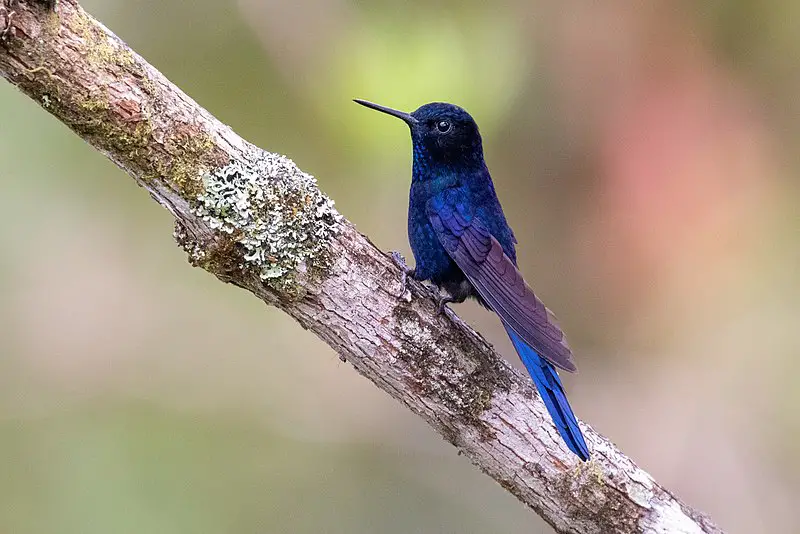
The Royal Sunangel is a rare and endangered hummingbird species found in the highlands of Ecuador and Peru.
It was first described in 1979 but only recently accepted as having two subspecies – Heliangelus regalis (the original) and Heliangelus r. Johnson (discovered in 2011).
This bird measures 10 and 12cm long, with its wingspan reaching up to 13cm wide.
Its plumage is primarily black or dark brown with green shimmering feathers on its back, giving it an elegant look.
Its striking head crests are bright yellow/orange, which contrast nicely against their bodies.
They feed mainly on nectar from flowers such as tall grasses, shrubs & trees like bromeliads & Fuchsias located near streams & rivers at altitudes ranging from 1,800–4200m above sea level.
Scientific classification:
| Kingdom | Animalia |
| Phylum | Chordata |
| Class | Aves |
| Order | Apodiformes |
| Family | Trochilidae |
| Genus | Heliangelus |
| Species | H. regalis |
20. Ruddy Ground-Dove
The Ruddy Ground-Dove is a small New World tropical bird across Mexico and South America as far south as Argentina. It is also seen in the southwestern United States during winter months.
This ground dove typically lives in scrub or other open habitats such as savannas and grasslands, where it feeds on seeds from plants like cactus fruits.
Its plumage ranges from grey to reddish-brown with a light tan breast and black markings throughout its wings and tail feathers.
The male has more distinguishable coloration than the female, but both sexes have bright red eyes, which give this species its name – ‘ruddy.’
They are often observed perching low to the ground near food sources or nesting sites while being quite vocal when flying between locations, making them easier to spot.
Scientific classification:
| Kingdom | Animalia |
| Phylum | Chordata |
| Class | Aves |
| Order | Columbiformes |
| Family | Columbidae |
| Genus | Columbia |
| Species | C. Talcott |
21. Scarlet Macaw
The Scarlet Macaw is a vibrant and beautiful bird in Central and South America. Its striking red, yellow, and blue feathers stand out among other parrots.
It inhabits humid evergreen forests of the Neotropics from Mexico to Peru, Ecuador, Colombia, Bolivia, Venezuela, and Brazil up to an altitude of 1000m (3300ft).
These birds have strong beaks, which they use to break open hard nuts or seeds that would otherwise remain inaccessible.
They also form social bonds with their mates by grooming each other’s feathers and engaging in playful activities such as chasing one another around tree trunks.
Despite its vivid colors, the Scarlet Macaw remains vulnerable due to habitat loss caused by deforestation. Hence, conservation efforts are essential if this fantastic species will survive for future generations.
Scientific classification:
| Kingdom | Animalia |
| Phylum | Chordata |
| Class | Aves |
| Order | Psittaciformes |
| Family | Psittacidae |
| Genus | Ara |
| Species | A. Macao |
22. Petrels
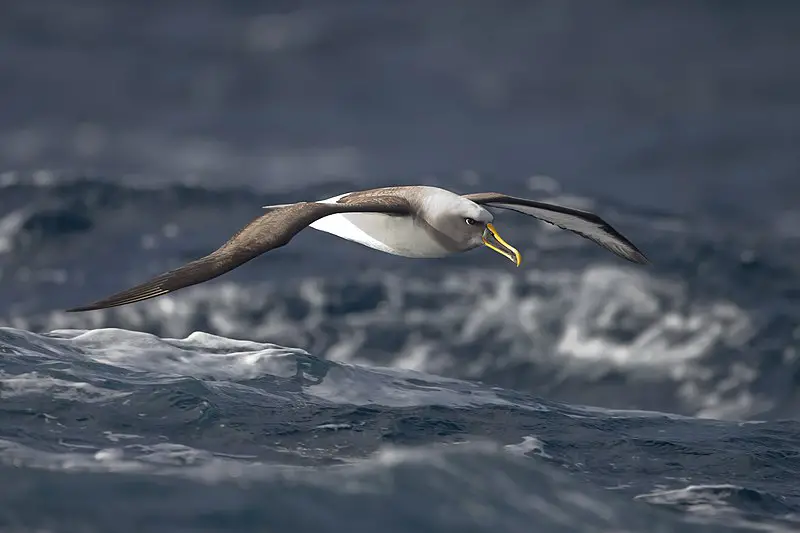
Petrels are seabirds that belong to the Procellariiformes order. They come from four families: albatrosses, petrels, shearwaters, and two storm petrel families.
Commonly referred to collectively as ‘petrels,’ these birds have a long history of being called Tubinares or tubenoses – referring to their distinctive beaks, which feature small tubes on either side to detect food in dark seawater.
Petrels mainly consume fish, squid, and other small marine creatures but also feed off carrion when needed.
These waterbirds can fly great distances over open oceans in search of food with no land insight.
Scientific classification:
| Kingdom | Animalia |
| Phylum | Chordata |
| Class | Aves |
| Clade | Austrodyptornithes |
| Order | Procellariiformes Fürbringer, 1888 |
23. Marbled Wood-Quail
The marbled wood quail (Odontophorus gujanensis) is a bird species in the New World quail family and has an extensive distribution across Central America and northern South America.
This unique species typically inhabits subtropical or tropical moist lowland forests, where it can be found hiding among thick vegetation.
It was formally described by German naturalist Johann Friedrich in 1789 and is recognizable for its short tail, grey legs, and brownish coloring with white spots on its wings.
The marbled wood quail is relatively tiny compared to other members of the Quails family, but what it lacks in size makes up for it with vocalizations; their loud calls are often heard throughout the forest.
Scientific classification:
| Kingdom | Animalia |
| Phylum | Chordata |
| Class | Aves |
| Order | Galliformes |
| Family | Odontophoridae |
| Genus | Odontophorus |
| Species | O. gujanensis |
24. Gould’s Jewelfront
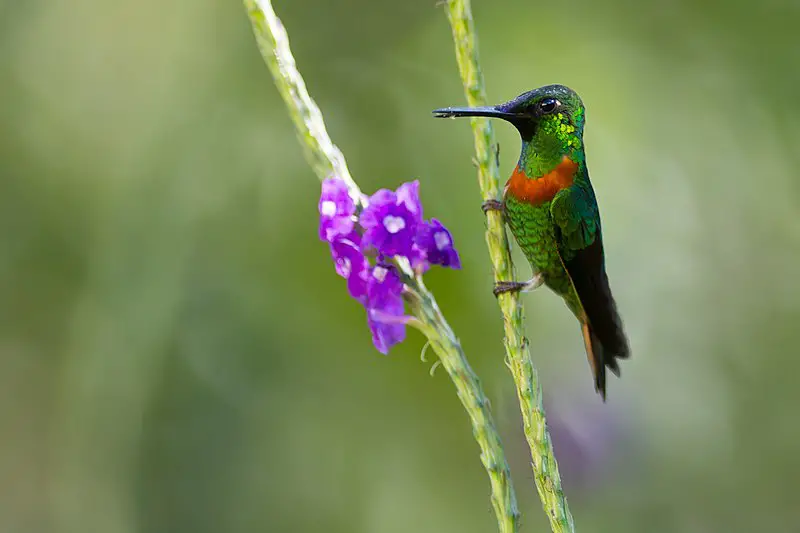
Gould’s Jewelfront is a medium-sized hummingbird in tropical and equatorial South America. It has an extensive range compared to other members of the Heliodoxa family, which likely contributes to its uncommon status.
The bird was named after English ornithologist and artist John Gould, who made significant contributions to understanding different species of birds all over the world.
This majestic little creature has bronze-green upper parts with ruby red throat patches on males, while females have grey throats instead.
Both sexes also feature glittering blue crowns and metallic purple wings, giving it a unique sparkle when looking for food, like tiny insects or nectar from flowers. It is a truly fascinating sight.
Scientific classification:
| Kingdom | Animalia |
| Phylum | Chordata |
| Class | Aves |
| Order | Apodiformes |
| Family | Trochilidae |
| Genus | Heliodoxa |
| Species | H. aurescens |
25. Crimson-mantled woodpecker
The Crimson-mantled Woodpecker is a beautiful and unique bird in Central America, particularly Mexico. It has predominantly red plumage on its back with some black markings along the wings and head, making it easily identifiable.
Its scientific name, Rivoli, honors French ornithologist François Victor Masséna, the third Duke of Rivoli and the third Prince of Essling.
The species belongs to the woodpecker family (Picidae) but was formerly placed under Piculus before mitochondrial DNA sequencing moved them into the Colaptes genus.
Interestingly enough, the sex determination of this species can be determined by their plumage coloration; males have brighter crimson mantles than females. This gorgeous bird is an incredible sight for any birder or nature lover alike.
Scientific classification:
| Kingdom | Animalia |
| Phylum | Chordata |
| Class | Aves |
| Order | Piciformes |
| Family | Picidae |
| Genus | Colaptes |
| Species | C. Rivoli |
26. Magnificent Frigatebird
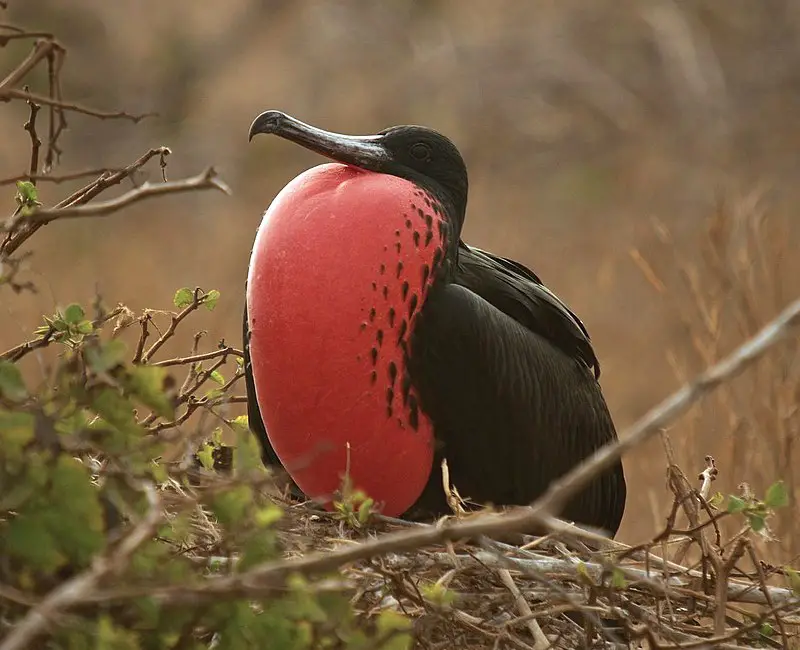
The Magnificent Frigatebird is the largest species, measuring between 89 and 114 cm in length and having a 7-8 ft wingspan.
It can be found over tropical waters off America from northern Mexico to Peru on the Pacific coast and in Florida down south.
Its diet consists mainly of fish they take from other seabirds or snatch directly from the ocean surface while flying low above it.
They also feed on crustaceans and squid when available.
This impressive bird has an unmistakable silhouette with its long pointed wings, forked tail feathers, and male’s red gular pouch, which inflates during courtship displays.
Scientific classification:
| Kingdom | Animalia |
| Phylum | Chordata |
| Class | Aves |
| Order | Suliformes |
| Family | Fregatidae |
| Genus | Fregata |
| Species | F. magnificent |
27. Anhinga
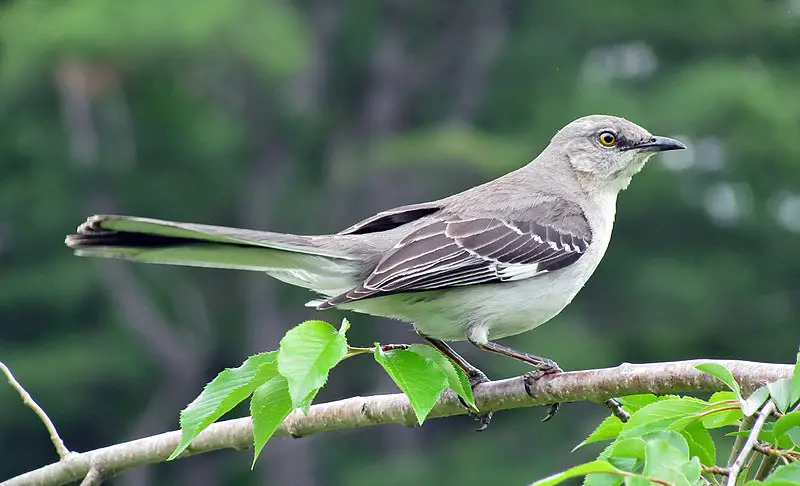
Anhinga birds, also called “snakebirds” for their long necks resembling snakes from the water, are large aquatic birds in wetlands throughout the Americas.
These black and white feathered creatures have a wingspan averaging 35-43 inches (90 -110 cm). They spend most of their time swimming or floating on the surface with just their heads visible above the water.
Anhingas hunt by spearing fish underwater using their sharp pointed bills; they then perch to dry off before swallowing them whole.
The males are more significant than females and display brilliant plumage during mating season when both sexes grow striking feathers around their neck and head as part of courtship rituals.
Anhingas nest near bodies of fresh or brackish water, where they lay up to 6 eggs at a time, which hatch after 25 25-day incubation period.
28. Stone-Curlew
Stone-curlews, also known as dikkops or thick-knees, are a family of birds that have adapted to live in tropical and temperate regions worldwide.
They can be found in Africa, Asia, and Australia, with two or more species per region. Despite being classified as waders, most prefer dry, arid habitats over moist wetlands.
Stone curlews typically have long legs, which help them navigate through their preferred terrain efficiently; some species even stand at impressive heights when standing on those long legs.
Additionally, they feature cryptic plumage, which helps them blend into their surroundings while hunting for prey such as insects and small mammals like rodents.
These unique birds’ calls are easily recognizable; it has been said that hearing one is similar to listening to someone whistling ‘Keee We.’
Scientific classification:
| Kingdom | Animalia |
| Phylum | Chordata |
| Class | Aves |
| Order | Charadriiformes |
| Suborder | Chionidi |
| Family | Burhinidae Mathews, 1912 |
29. Heliornithidae
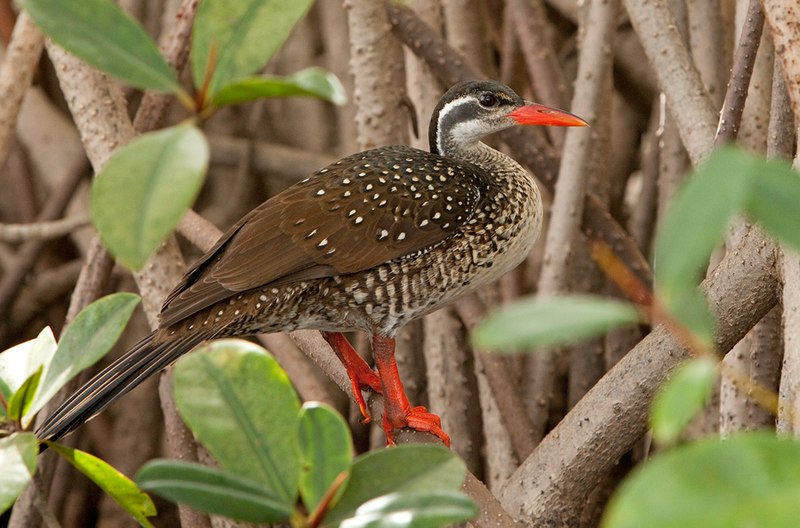
Heliornithidae, commonly known as finfoots, are a small family of tropical birds in South America and Africa. They have webbed feet like grebes or coots, long necks, slender bodies, and broad tails with sharp, pointed bills.
Their diverse calls include whistles, squawks, and croaks, which they use to communicate.
Finfoots feed mainly on fish but also consume insects such as water beetles and dragonflies near the surface of water bodies.
They nest around rivers or lakes with plenty of cover from predators such as eagles or hawks.
During the breeding season, males can become quite territorial, defending their territories against intruders by chasing them off aggressively using loud noises or even physical contact if necessary.
Scientific classification:
| Kingdom | Animalia |
| Phylum | Chordata |
| Class | Aves |
| Order | Gruiformes |
| Family | Heliornithidae GR Gray, 1840 |
30. Seedsnipe
Seedsnipes are small wading birds from South America, mainly found in the Andean and Patagonian regions. They form two genera – Attagis and Thinocorus – each containing two species.
Seedsnipes live in flocks and have adapted to a herbivorous diet. Although their exact relationship with other families of the Charadriiformes order is unknown, it has been suggested that they may be related to plovers or sandpipers.
These tiny birds feed on vegetation such as grass seeds, buds, shoots, and leaves, which they find among rocks or sparsely vegetated areas at high altitudes. Their brown-and-white plumage blends perfectly into their environment, making them difficult to spot while feeding.
Scientific classification:
| Kingdom | Animalia |
| Phylum | Chordata |
| Class | Aves |
| Order | Charadriiformes |
| Suborder | Thinocori |
| Family | Thinocoridae Gray, 1845 |
31. New World Quail
New World quail are small birds found in the Americas, from Canada to Brazil. They belong to their family, Odontophoridae, and have similar appearances and habits as Old World quail, belonging to a different family.
New World Quails come in various species, such as California Quail and Bobwhite Quail.
These birds have adapted well to human presence due to the availability of food resources like crops.
They also live close together, forming large flocks for safety against predators like foxes or hawks.
The males usually sport colorful feathers during mating season that help them attract female mates while providing a fantastic sight for viewers.
Scientific classification:
| Kingdom | Animalia |
| Phylum | Chordata |
| Class | Aves |
| Order | Galliformes |
| Superfamily | Phasianoidea |
| Family | Odontophoridae Gould, 1844 |
32. Psophia
Psophia is a genus of birds found in South America and are the only members of the Psophiidae family. They have an unmistakable appearance, with their long legs and necks giving them a chicken-like stature.
Males make loud trumpeting or cackling noises when they feel threatened. The three species range from 45 to 52 centimeters (18 to 20 inches) in length, weighing up to 1.5 kg (2 lbs).
They live mainly in humid forests across the Amazon and Guiana Shield regions, where there is plenty to forage, such as fruit, insects, and small animals like lizards or frogs.
These fascinating creatures play an important role within their environment, helping disperse seeds throughout the forest by eating fruits that contain large quantities of seeds that will eventually be spread elsewhere through defecation.
Scientific classification:
| Kingdom | Animalia |
| Phylum | Chordata |
| Class | Aves |
| Order | Gruiformes |
| Family | Psophiidae Bonaparte, 1831 |
| Genus | Psophia Linnaeus, 1758 |
33. Stilts And Avocets
Stilts and avocets are two distinct birds belonging to the Recurvirostridae family. They range in length from 30-46 cm (12-18 inches) and weigh between 140 – 435 g (4.9 – 15.3 ounces).
Males usually have slightly larger bodies than females, with long, thin legs, necks, and bills.
Avocet bills curve upwards uniquely, while stilt beaks remain straight most times.
These wading birds live mainly near shorelines or wetlands, feeding on aquatic invertebrates like brine shrimp, insects, etc., occasionally supplementing their diet with seeds or small fish.
Stilts also inhabit open fields searching for food sources, such as earthworms or grasshoppers during the non-breeding season.
Both groups migrate over large distances for warmer weather when it gets cold outside.
Scientific classification:
| Kingdom | Animalia |
| Phylum | Chordata |
| Class | Aves |
| Order | Charadriiformes |
| Suborder | Charadrii |
| Family | Recurvirostridae Bonaparte, 1854 |
34. American Golden Plover

The American golden plover (Pluvialis dominica) is a medium-sized bird, part of the genus Pluvialis, which translates to “relating to rain.”
It was named after Santo Domingo in the West Indies, and it is believed that it predicted an upcoming rainfall when they flocked.
Their nests are lined with spores picked up from their habitat – this also helps protect eggs against predators or parasites.
The birds have distinctive yellow and black plumage, allowing them to stand out amongst other species and making them more accessible for predators to spot.
They can fly great distances during migration season and inhabit open grasslands and arctic tundra regions all over North America throughout different times of the year.
Scientific classification:
| Kingdom | Animalia |
| Phylum | Chordata |
| Class | Aves |
| Order | Charadriiformes |
| Family | Charadriidae |
| Genus | Pluvialis |
| Species | P. Dominica |
35. Red-Billed Tropicbird
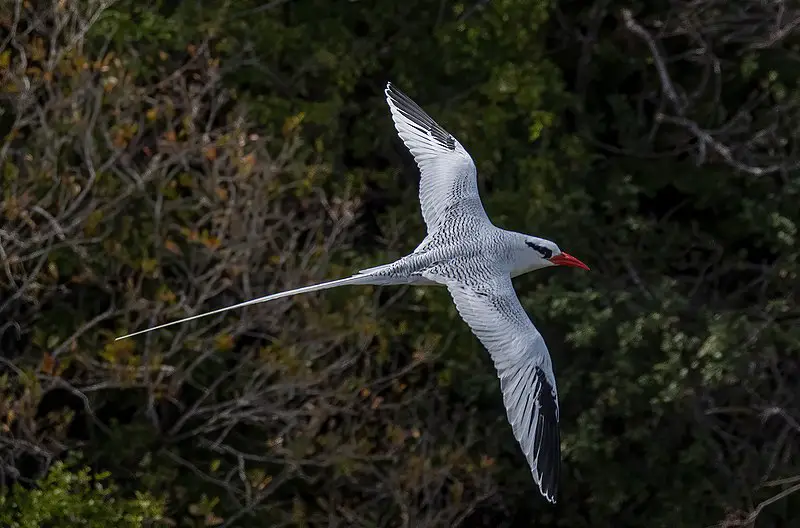
The Red-billed Tropicbird is a beautiful seabird found in tropical oceans. It has mainly white plumage, black markings on its wings and back, a black mask, and a red bill.
These birds have distinctive long tail streamers twice their body length, which they use to soar above the ocean surface while searching for food.
They primarily feed off squid, fish, and crustaceans that inhabit coral reefs or deep-sea areas where they can dive up to 30 meters below the water’s surface.
The Red-billed Tropicbird was once thought of as an omen of bad luck, but now it serves as a reminder of how delicate our marine ecosystems are when faced with human activity such as overfishing.
Scientific classification:
| Kingdom | Animalia |
| Phylum | Chordata |
| Class | Aves |
| Order | Phaethontiformes |
| Family | Phaethontidae |
| Genus | Phaethon |
| Species | P. aethereus |
36. Spot-Fronted Swift
The Spot-fronted Swift is a species of bird belonging to the subfamily Cypseloidinae of the swift family Apodidae.
It inhabits parts of Colombia, Costa Rica, Ecuador, Panama, Peru, and Venezuela and measures approximately 14 cm (5.5 in) long with an average weight of 23 g (0.81 oz).
Males and females appear identical, almost entirely blackish brown in coloration, except for its distinctive white forehead spot, which gives it its name.
These birds feed mainly on insects taken while flying but occasionally visit flowers or catch prey from leaves or branches near water sources such as rivers or small lakes.
They are known to form large flocks during migration periods when traveling great distances northwards each year between breeding grounds and wintering habitats, with some pairs even crossing oceans.
Scientific classification:
| Kingdom | Animalia |
| Phylum | Chordata |
| Class | Aves |
| Order | Apodiformes |
| Family | Apodidae |
| Genus | Cypseloides |
| Species | C. cherries |
37. Maguari Stork
The Maguari stork is a large species of stork found in South America. It has similar features to the white stork but is slightly larger.
This bird can be identified by its black body with white patches on its wings, tail feathers, and yellow legs, contrasting with its dark feathers.
The maguari feeds mainly on fish, amphibians, reptiles, crustaceans, and insects; they will also scavenge for food when necessary.
These birds breed during wetland seasons, where their nests are made of sticks or reeds built high above the ground in trees near water bodies such as rivers or swamps.
Their populations have been decreasing due to habitat loss from human activities such as agricultural expansion or deforestation; however, conservation efforts are being put into place to help protect this unique species so that we may continue to enjoy watching these magnificent birds soar through our skies.
Scientific classification:
| Kingdom | Animalia |
| Phylum | Chordata |
| Class | Aves |
| Order | Ciconiiformes |
| Family | Ciconiidae |
| Genus | Ciconia |
| Species | C. maguari |
38. Rufous-Bellied Seedsnipe
The Rufous-bellied seedsnipe is a shorebird found in Argentina, Bolivia, Chile, Ecuador, and Peru. It belongs to the suborder Scolopaci of order Charadriiformes and shares its genus with the white-bellied seedsnipe (A.
malouinus). This species has three different subspecies. The first is Attagis gayi albifrons, which inhabit western coastal regions of South America from northern Peru to north-central Chile.
A. g. Patagonia, located in southern Patagonia between 40°S and 55°S latitude; A.g..gayi, living mainly on grassland steppes at higher altitudes within this same region and parts of northwestern Argentina near Mendoza province.
The main predators for these birds are skuas and gulls, who take advantage when they flush up food during feeding or other disturbances caused by humans or animals nearby during nesting or breeding season.
Scientific classification:
| Kingdom | Animalia |
| Phylum | Chordata |
| Class | Aves |
| Order | Charadriiformes |
| Family | Thinocoridae |
| Genus | Attagis |
| Species | A. gayi |
39. Horned Screamer
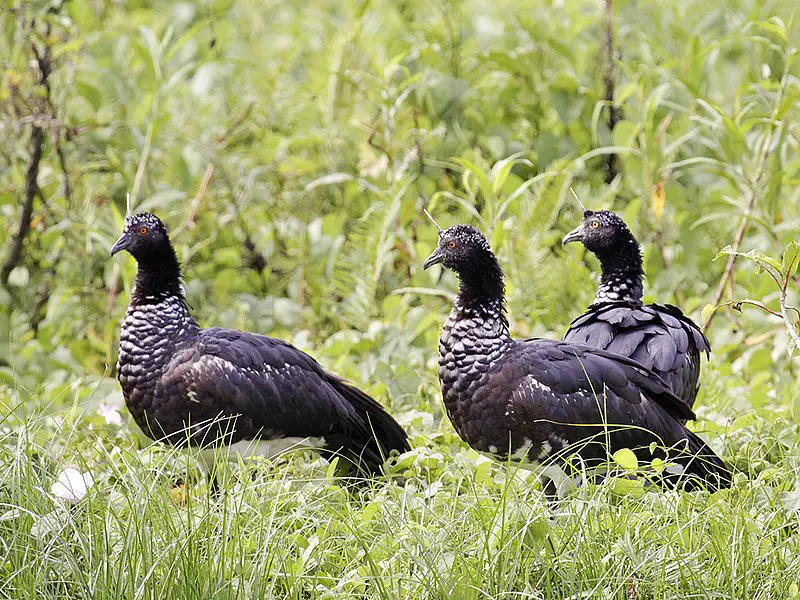
The Horned screamer is a unique species of bird found in the wetlands of tropical South America. It belongs to the Anhimidae family and is related to ducks, geese, and swans, all of which are in the Anatidae family.
The most distinctive feature of this particular species is its large protruding horns on top of its head.
These help them protect themselves from predators and make loud calls when they feel threatened or need to alert their flockmates that danger may be near.
They also have powerful legs for swimming through water and can reach speeds up to 40 km/h.
Despite their small size compared with other family members, these birds can live up to 20 years in captivity, making them an exciting addition to any wildlife enthusiast’s collection.
Scientific classification:
| Kingdom | Animalia |
| Phylum | Chordata |
| Class | Aves |
| Order | Anseriformes |
| Family | Anhimidae |
| Genus | Anhima Brisson, 1760 |
| Species | A. cornuta |
Also Featured In: Birds That Live in the Jungle,
40. Cape Gannet
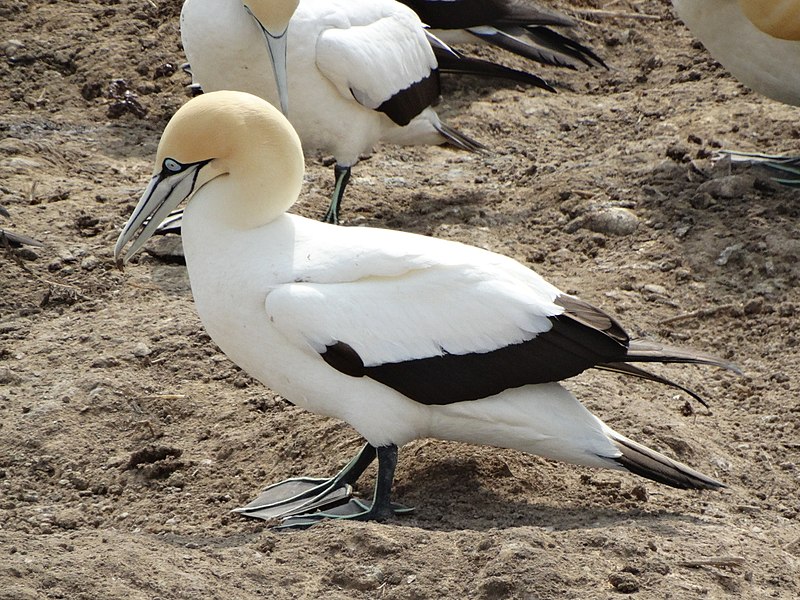
The Cape Gannet is a majestic seabird of the Sulidae family, easily recognized by its large size and striking black-and-white plumage.
Its head and hind neck are strikingly yellow, while its pale blue bill is pointed with fine serrations near the tip.
These birds are renowned for their incredible diving abilities; they can plunge up to 25 meters underwater at over 60 kilometers per hour in pursuit of fish.
The gannets also work together as teams when fishing, creating impressive “bait balls” that draw shoals closer before being devoured.
Their diets mainly consist of small schooling fish such as sardines or anchovies, squid, and crustaceans, which may also be eaten occasionally.
These remarkable creatures make an unforgettable sight at sea – soaring gracefully above the waves or plunging beneath them in search of food.
Scientific classification:
| Kingdom | Animalia |
| Phylum | Chordata |
| Class | Aves |
| Order | Suliformes |
| Family | Sulidae |
| Genus | Morus |
| Species | M. capensis |
41. Flamingos

Anhinga birds, also called “snakebirds” for their long necks resembling snakes from the water, are large aquatic birds in wetlands throughout the Americas.
These black and white feathered creatures have a wingspan averaging 35-43 inches (90 -110 cm). They spend most of their time swimming or floating on the surface with just their heads visible above the water.
Anhingas hunt by spearing fish underwater using their sharp pointed bills; they then perch to dry off before swallowing them whole.
The males are more significant than females and display brilliant plumage during mating season when both sexes grow striking feathers around their neck and head as part of courtship rituals.
Anhingas nest near bodies of fresh or brackish water, where they lay up to 6 eggs at a time, which hatch after 25 25-day incubation period.
42. Chilean Skua
The Chilean Skua is a large predatory seabird found in South America. It can be recognized by its dark cap that contrasts with the cinnamon-colored throat and lower face.
When not breeding, these birds wander as far north as Brazil and Peru but are primarily concentrated around Argentina and Chile.
Hybridization between this species of Skua and brown skuas has been observed in southern Argentina.
The Chilean Skua measures approximately 55 cm long, making it smaller than some other varieties of sea birds. However, they make up for their size with aggression towards competitors or intruders near nesting areas.
Scientific classification:
| Kingdom | Animalia |
| Phylum | Chordata |
| Class | Aves |
| Order | Charadriiformes |
| Family | Stercorariidae |
| Genus | Stercorarius |
| Species | S. chilensis |
Also Featured In Common Birds that Live around Ushuaia,
43. Peruvian Pelican
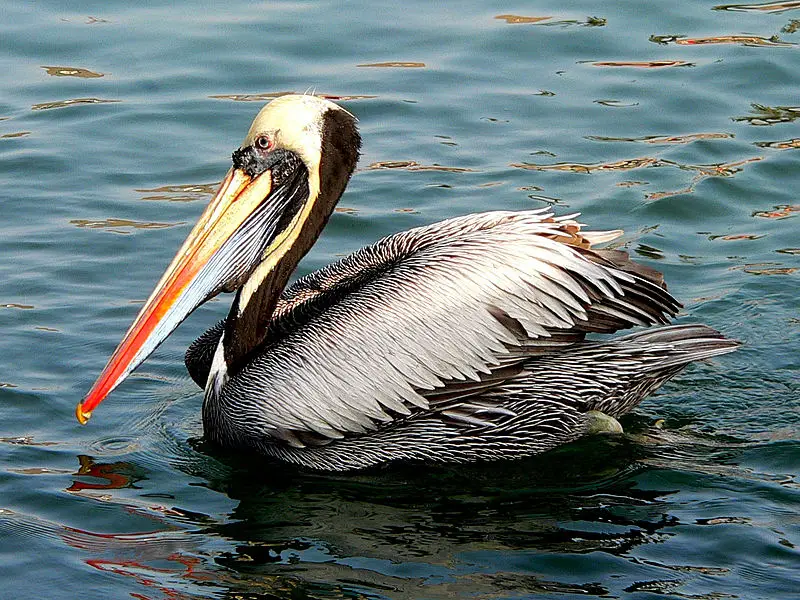
The Peruvian Pelican is a beautiful bird species native to the western coast of South America. They have dark plumage with a distinctive white stripe that runs from their bill to the crown and down both sides of their neck.
These majestic birds can be found in Chile, Peru, Ecuador, and sometimes even further south.
They live in colonies near coastal areas where they feed on fish they catch by diving into the water or scooping them off the surface using their large bills.
The population is decreasing due to overfishing, pollution, and bandit destruction caused by human activities like mining, construction, and agricultural development.
Conservation efforts are needed if we want these magnificent animals around for future generations.
Scientific classification:
| Kingdom | Animalia |
| Phylum | Chordata |
| Class | Aves |
| Order | Pelecaniformes |
| Family | Pelecanidae |
| Genus | Pelecanus |
| Species | P. thagus |
44. Festive Amazon
The Festive Amazon is a vibrant parrot species in Brazil, Colombia, Ecuador, Bolivia, Guyana, and Venezuela. It inhabits tropical forests near the significant rivers of these countries as well as coastal mangroves in Amapá.
This beautiful bird has two subspecies – A. f festiva and A. amazonica- which differ slightly in their physical characteristics, such as size and plumage coloration.
The festive amazon measures 33-35 cm long, with its wingspan reaching up to 45cm, making it one of the most giant parrots found in South America.
Its signature bright green feathers are complemented by yellow patches on its chest area, creating an eye-catching display, genuinely living up to its name, ‘Festive.’
Scientific classification:
| Kingdom | Animalia |
| Phylum | Chordata |
| Class | Aves |
| Order | Psittaciformes |
| Family | Psittacidae |
| Genus | Amazon |
| Species | A. festival |
Also Featured In Rainforest Birds You Should Know, Birds that Live in Guyana
45. Scarlet-Shouldered Parrotlet
The Scarlet-shouldered parrotlet is a species of bird native to South America. It typically measures 16 cm in length and weighs 60g, with its distinguishing physical feature being bright red wings.
These birds live within subtropical or tropical moist lowland forests in Bolivia, Brazil, Colombia, Ecuador, Guyana, Peru, Trinidad and Tobago, and Venezuela. They feed on various seeds from plants, such as fruits and berries, which they find near their habitat.
The scarlet shoulder parrots tend to live in small flocks made up of family members but also join larger groups during migration season for protection against predators like hawks or owls.
Scientific classification:
| Kingdom | Animalia |
| Phylum | Chordata |
| Class | Aves |
| Order | Psittaciformes |
| Family | Psittacidae |
| Genus | Touit |
| Species | T. hentai |
46. Groove-Billed Ani
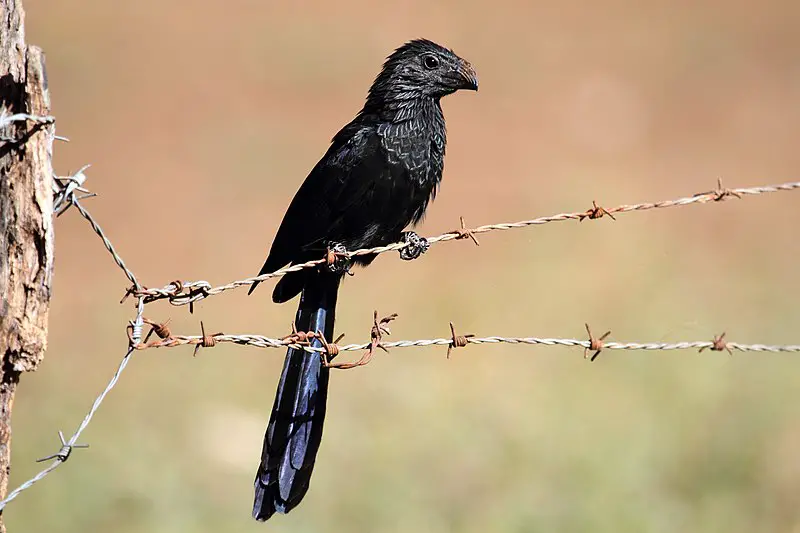
The Groove-billed ani is a tropical bird belonging to the cuckoo family. It has a long tail and a large, curved beak.
This species can be found in many parts of Central America, from southern Texas to northern Colombia and Venezuela, as well as coastal Ecuador and Peru.
In some places, they may retreat during colder months but are considered resident birds throughout their range.
They prefer open woodlands near water sources like mangroves or swamps where there are plenty of insects to feed on, such as grasshoppers and beetles.
The beautiful coloration of this species ranges from blackish brown with orange spots on its wings that give way to bright blue feathers at the end of its tail, making it quite striking.
Scientific classification:
| Kingdom | Animalia |
| Phylum | Chordata |
| Class | Aves |
| Order | Cuculiformes |
| Family | Cuculidae |
| Genus | Crotophaga |
| Species | C. sulcirostris |
Also Featured In: Birds You’ll Find in South Texas, Birds that Live in the Grand Canyon National Park
47. White-Throated Toucan
The White-throated Toucan is an exotic bird in the Amazon Basin, extending to parts of the Tocantins and Araguaia Rivers.
It inhabits tropical humid forests, woodlands, and cerrado areas near rivers.
Swedish naturalist Carl von Linne formally described this colorful bird in 1758 and gave it the scientific name ‘Ramphastos toucans.’
The most distinctive feature of this species is its vast bill, which measures from 14 cm to 20 cm long.
Its plumage consists mainly of black feathers with white throat patches on either side; red undertail coverts are also present.
In addition, they have a loud call consisting of three notes: “know,” “task,” or “keh.” These fantastic birds feed primarily on fruits but occasionally consume insects, too.
All these features make them stand out amongst other birds.
Scientific classification:
| Kingdom | Animalia |
| Phylum | Chordata |
| Class | Aves |
| Order | Piciformes |
| Family | Ramphastidae |
| Genus | Ramphastos |
| Species | R. Tucanes |
48. Rufous Potoo
The Rufous Potoo is a species of bird found in South America. It is the only member of its genus, Phyllaemulor, and belongs to the Nyctibiidae family. This nocturnal creature can be identified by its unique plumage, which includes reddish-brown upper parts with black bars on wings and tail feathers.
Its lower parts are white or pale grey with barring on the flanks and chest area. The rufous potoo feeds mainly on insects such as moths, beetles, crickets, and other arthropods that it catches mid-air while flying from one perch to another at night using its long bill for hunting prey items.
Its voice consists of loud whistles that echo through jungle nights, making it easy to identify this solitary bird’s call for miles around.
Scientific classification:
| Kingdom | Animalia |
| Phylum | Chordata |
| Class | Aves |
| Order | Nyctibiiformes |
| Family | Nyctibiidae |
| Subfamily | Nyctibiinae |
| Genus | Phyllaemulor Costa, Whitney, Braun, White, Silveira & Cleere, 2018 |
| Species | P. bracteatus |
49. Masked Trogon
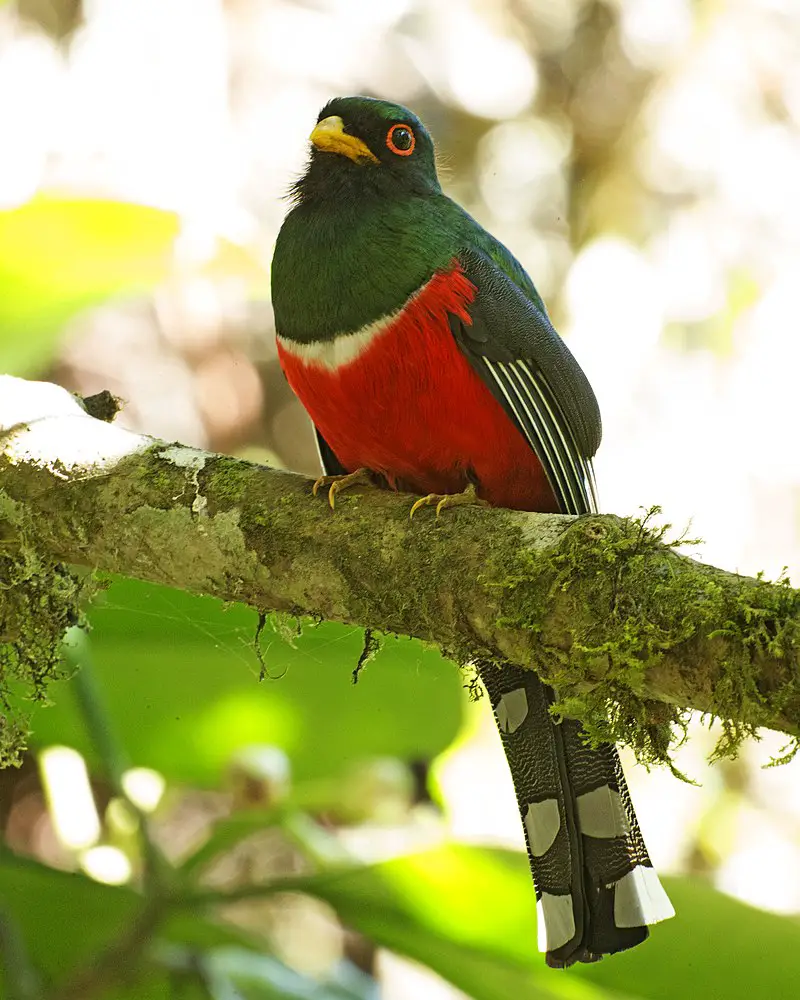
The Masked Trogon (Trogon personatus) is a species of bird belonging to the family Trogonidae. It’s common in humid highland forests across South America, particularly in the Andes and Tepuis mountain ranges.
This magnificent creature has eight recognized subspecies, an average length of 27 cm, and a mass of 56 grams with distinct sexual dimorphism.
This beautiful bird typically displays shades of green and blue-grey with its vivid yellow breast, their distinguishing feature among other birds.
Their diet consists mainly of various insects, but they feed upon small vertebrates such as geckos or lizards if available. The masked trogons frequently live in solitary life while at times can be seen perching on treetops alone – making them easy to spot by nature enthusiasts.
Scientific classification:
| Kingdom | Animalia |
| Phylum | Chordata |
| Class | Aves |
| Order | Trogoniformes |
| Family | Trogonidae |
| Genus | Trogon |
| Species | T. personatus |
Conclusion
Peru boasts an extraordinary diversity of bird species, with many unique and captivating avian inhabitants. From the vibrant plumage of the Andean Cock-of-the-rock to the elusive beauty of the Long-whiskered Owlet, Peru’s birdlife offers a rich tapestry of colors, behaviors, and habitats.
Exploring the country’s varied ecosystems, from the dense Amazon rainforest to the high-altitude Andes mountains, reveals a treasure trove of avian wonders found nowhere else on Earth.
Conservation efforts are paramount to ensure the continued survival of these remarkable creatures, allowing future generations to marvel at the unparalleled beauty and biodiversity of Peru’s birdlife.